A Detecting Method for “Weak” Friction-Induced Vibration Based on Cross-Correlation Analysis between Vibration and Sound Signals
Abstract
1. Introduction
2. Experiment
2.1. Apparatus
2.2. Friction Pairs
2.3. Wear Test
3. Implementation Method
3.1. Cross-Correlation Analysis
3.1.1. Cross-Correlation Function
3.1.2. Denoise Principle of CCA
3.2. Determining the Frequency Range of “Weak” FIV
3.3. Extraction
4. Results and Discussion
4.1. Extraction of “Weak” FIV
4.1.1. Spectrum Analysis for CCF of Original Vibration and Sound Pressure Signals
4.1.2. Frequency Range Identification
4.2. Variation of the “Weak” FIV Signals
4.2.1. Wear State Change Analysis
4.2.2. Change of the Extracted “Weak” FIV
5. Conclusions
Author Contributions
Funding
Institutional Review Board Statement
Informed Consent Statement
Data Availability Statement
Acknowledgments
Conflicts of Interest
Appendix A. The Original Images of the Experimental Setup

Appendix B. The Basic Parameters of the Accelerometer and Microphone
| Name | Parameters |
|---|---|
| Sensitivity | 10.0 mv/g |
| Frequency response | ±0.5~12,000.0 Hz |
| Measuring range | ±500 g pk |
| Resolution | 0.002 g rms |
| Temperature range | −54~+121 °C |
| Weight | 3.1 g |
| Name | Parameters |
|---|---|
| Frequency range | 10.0~20.0 kHz |
| Setting sensitivity@250 Hz | 9.0 Pa |
| Output resistance | <50 Ω |
| Temperature range, operation | −10~50 °C |
| Temperature range, storage | 14~122 °C |
| Weight | 5.5 g |
References
- Wen, S.Z.; Huang, P. Principles of Tribology; Tsinghua University Press: Beijing, China, 2008. [Google Scholar]
- Holmberg, K.; Kivikytö-Reponen, P.; Härkisaari, P.; Valtonen, K.; Erdemir, A. Global energy consumption due to friction and wear in the mining industry. Tribol. Int. 2017, 115, 116–139. [Google Scholar] [CrossRef]
- Luo, Y.-K.; Zhou, L.; Ni, Y.-Q. Towards the understanding of wheel-rail flange squeal: In-situ experiment and genuine 3D profile-enhanced transient modelling. Mech. Syst. Signal Process. 2022, 180, 109455. [Google Scholar] [CrossRef]
- Qin, H.; Yang, C.; Zhu, H.; Li, X.; Li, Z.; Xu, X. Experimental analysis on friction-induced vibration of water-lubricated bearings in a submarine propulsion system. Ocean. Eng. 2020, 203, 107239. [Google Scholar]
- Stender, M.; Oberst, S.; Tiedemann, M.; Hoffmann, N. Complex machine dynamics: Systematic recurrence quantification analysis of disk brake vibration data. Nonlinear Dyn. 2019, 97, 2483–2497. [Google Scholar] [CrossRef]
- Li, D.; Cao, H.; Chen, X. Active control of milling chatter considering the coupling effect of spindle-tool and workpiece systems. Mech. Syst. Signal Process. 2022, 169, 108769. [Google Scholar] [CrossRef]
- Adnan, A. Acoustics of friction. J. Acoust. Soc. Am. 2002, 111, 1525–1548. [Google Scholar]
- Na, T.T.; Haur, H.J.; Lin, H.Y. Correlation between tribological and vibration behaviors in sliding lubricated contacts. J. Tribol. 2022, 144, 111603. [Google Scholar]
- Stender, M.; Tiedemann, M.; Hoffmann, L.; Hoffmann, N. Determining growth rates of instabilities from time-series vibration data: Methods and applications for brake squeal. Mech. Syst. Signal Process. 2019, 129, 250–264. [Google Scholar] [CrossRef]
- Abdelounis, H.B.; Bot, A.L.; Liaudet, J.P.; Zahouani, H. An experimental study on roughness noise of dry rough flat surfaces. Wear 2009, 268, 335–345. [Google Scholar] [CrossRef]
- Seong, Y.; Lee, D.; Yeom, J.; Park, J. The Feature Extraction through Wavelet Coefficients of Metal Friction Noise for Adhesive and Abrasive Wear Monitoring. Appl. Sci. 2021, 11, 3755. [Google Scholar] [CrossRef]
- Xu, C.; Wu, T.; Yang, H.; Wu, H.; Kwok, N. Study on vibration mechanism induced by skidding in pure rolling contact. Tribol. Int. 2021, 154, 106669. [Google Scholar] [CrossRef]
- Lacerra, G.; Di Bartolomeo, M.; Milana, S.; Baillet, L.; Chatelet, E.; Massi, F. Validation of a new frictional law for simulating friction-induced vibrations of rough surfaces. Tribol. Int. 2018, 121, 468–480. [Google Scholar] [CrossRef]
- Sun, D.; Li, G.; Wei, H.; Liao, H. Experimental study on the chaotic attractor evolvement of the friction vibration in a running-in process. Tribol. Int. 2015, 88, 290–297. [Google Scholar] [CrossRef]
- Ding, C.; Zhu, H.; Sun, G.; Zhou, Y.; Zuo, X. Chaotic characteristics and attractor evolution of friction noise during friction process. Friction 2017, 6, 47–61. [Google Scholar] [CrossRef]
- Ding, C.; Zhu, H.; Jiang, Y.; Sun, G.; Wei, C. Recursive Characteristics of a Running-in Attractor in a Ring-on-Disk Tribosystem. J. Tribol. 2019, 141, 011604. [Google Scholar] [CrossRef]
- Li, J.; Wei, H.; Fan, L.; Wei, L. Multifractal Detrended Fluctuation Analysis of Frictional Vibration Signals in the Running-in Wear Process. Tribol. Lett. 2017, 65, 50. [Google Scholar] [CrossRef]
- Chen, J.; Tang, L.; Ding, X.; Si, J.; Chen, D.; Sun, B. Frictional Vibration Performances of Dry Gas Seal Rings with DLC Film Textured Surface via Chaos Theory. Tribol. Trans. 2021, 64, 667–678. [Google Scholar] [CrossRef]
- Xu, C.; Li, B.; Wu, T. Wear characterization under sliding-rolling contact using friction-induced vibration features. Proc. Inst. Mech. Eng. Part J J. Eng. Tribol. 2022, 236, 634–647. [Google Scholar] [CrossRef]
- Di Bartolomeo, M.; Lacerra, G.; Baillet, L.; Chatelet, E.; Massi, F. Parametrical experimental and numerical analysis on friction-induced vibrations by a simple frictional system. Tribol. Int. 2017, 112, 47–57. [Google Scholar] [CrossRef]
- Liu, T.; Li, G.; Wei, H.; Sun, D. Experimental observation of cross correlation between tangential friction vibration and normal friction vibration in a running-in process. Tribol. Int. 2016, 97, 77–88. [Google Scholar] [CrossRef]
- Yu, H.; Wei, H.; Zhou, D.; Li, J.; Liu, H. Reconstruction and information entropy analysis of frictional vibration signals in running-in progress. Ind. Lubr. Tribol. 2021, 73, 937–944. [Google Scholar] [CrossRef]
- Mai, Y.; Liu, Z.; Wang, S.; Dong, B. Experimental Investigation into Friction-induced Squeal of Rotating-sliding Friction. China Mech. Eng. 2017, 28, 2198–2203, 2208. [Google Scholar]
- Mo, J.; Wang, Z.; Chen, G.; Shao, T.; Zhu, M.; Zhou, Z. The effect of groove-textured surface on friction and wear and friction-induced vibration and noise. Wear 2013, 301, 671–681. [Google Scholar] [CrossRef]
- Wernitz, B.; Hoffmann, N. Recurrence analysis and phase space reconstruction of irregular vibration in friction brakes: Signatures of chaos in steady sliding. J. Sound Vib. 2012, 331, 3887–3896. [Google Scholar] [CrossRef]
- Dong, C.; Mo, J.; Yuan, C.; Bai, X.; Tian, Y. Vibration and Noise Behaviors during Stick–Slip Friction. Tribol. Lett. 2019, 67, 103. [Google Scholar] [CrossRef]
- Sun, X.-Y.; Wang, Z.-Y.; Kang, F.-N.; Li, W.-F. Method of rock bolts parameters detection based on harmonic wavelet packet transform. In Proceedings of the International Conference on Machine Learning and Cybernetics (ICMLC), Guangzhou, China, 12–15 July 2015; Volume 2. [Google Scholar]
- Huang, H.; Xue, W.; Pang, Q. Separation method of rolling bearing compound fault characteristics based on Improved harmonic wavelet packet decomposition and fast ICA. J. Mech. Sci. Technol. 2022, 36, 3263–3276. [Google Scholar] [CrossRef]
- Liu, T.; Li, G.; Wei, H.; Xing, P. Stability analysis of tribosystem based on the energy feature of friction vibration. J. Tribol. 2017, 139, 051604. [Google Scholar] [CrossRef]
- Sun, G.; Zhu, H. Characteristic parameter extraction of running-in attractors based on phase trajectory and grey relation analysis. Nonlinear Dyn. 2019, 95, 3115–3126. [Google Scholar] [CrossRef]
- Peng, M.; Zhou, Y.; Zuo, X. Application of recurrence dynamic analysis to running-in state recognition. Ind. Lubr. Tribol. 2021, 73, 756–764. [Google Scholar] [CrossRef]

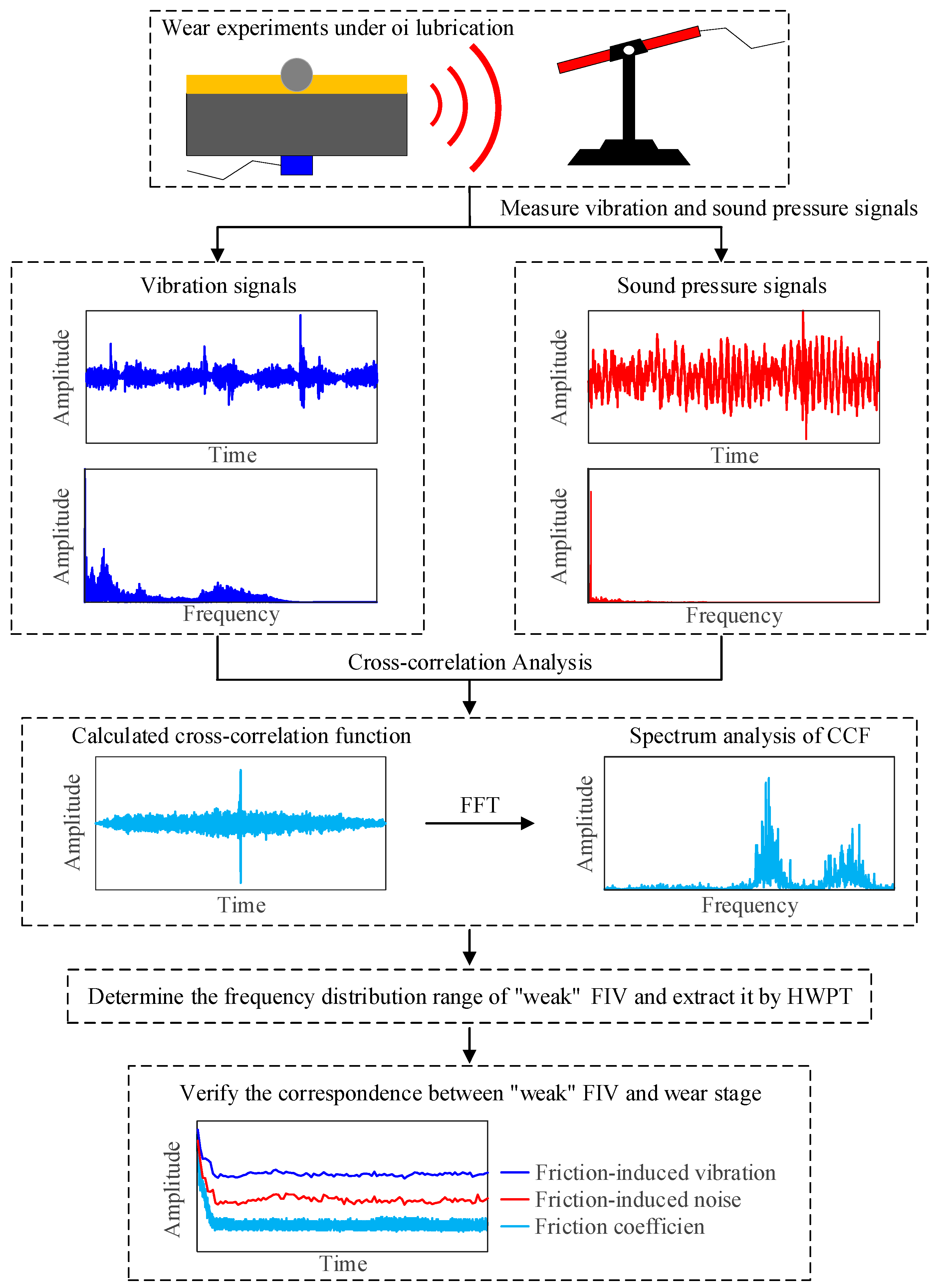
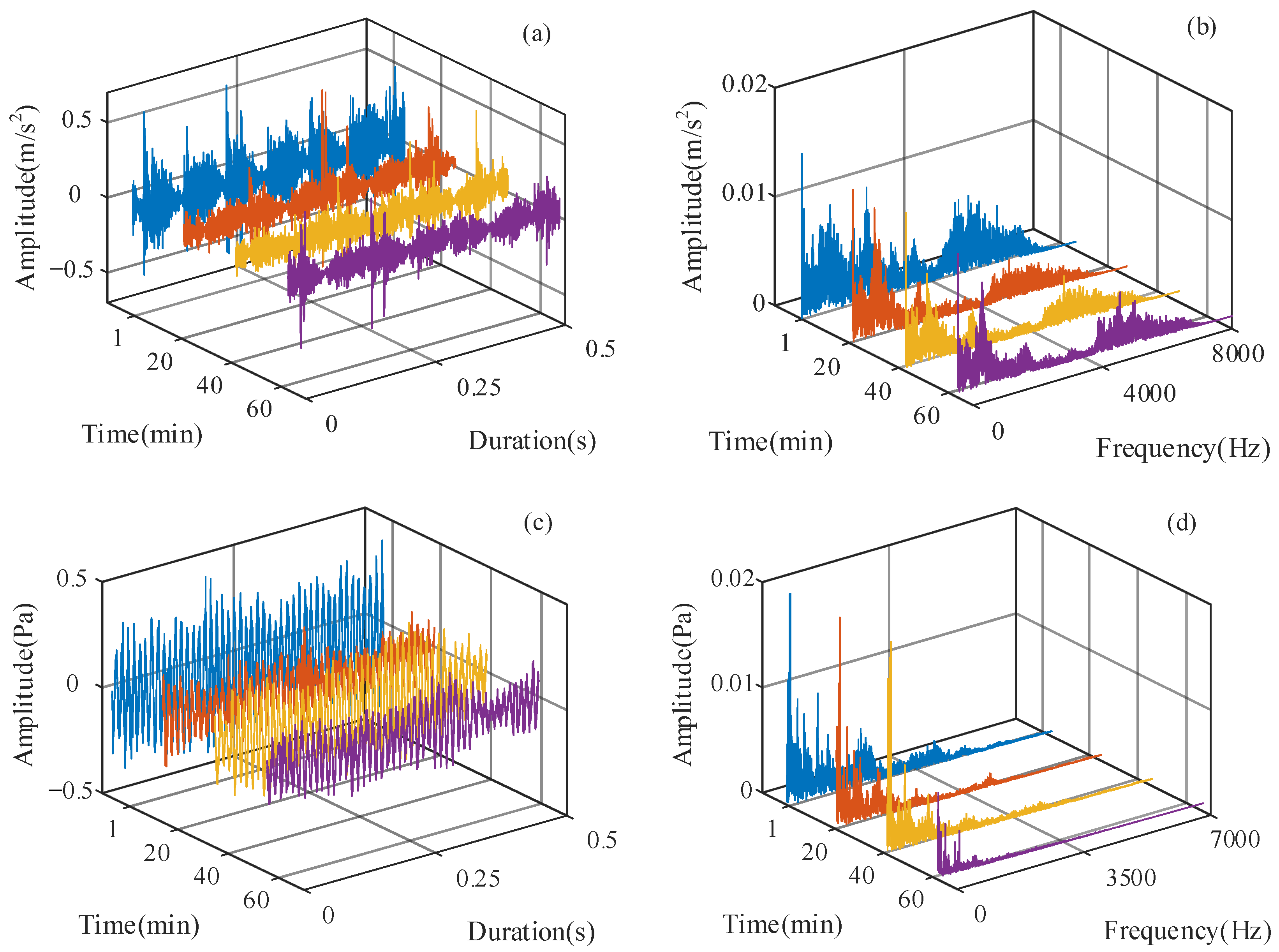
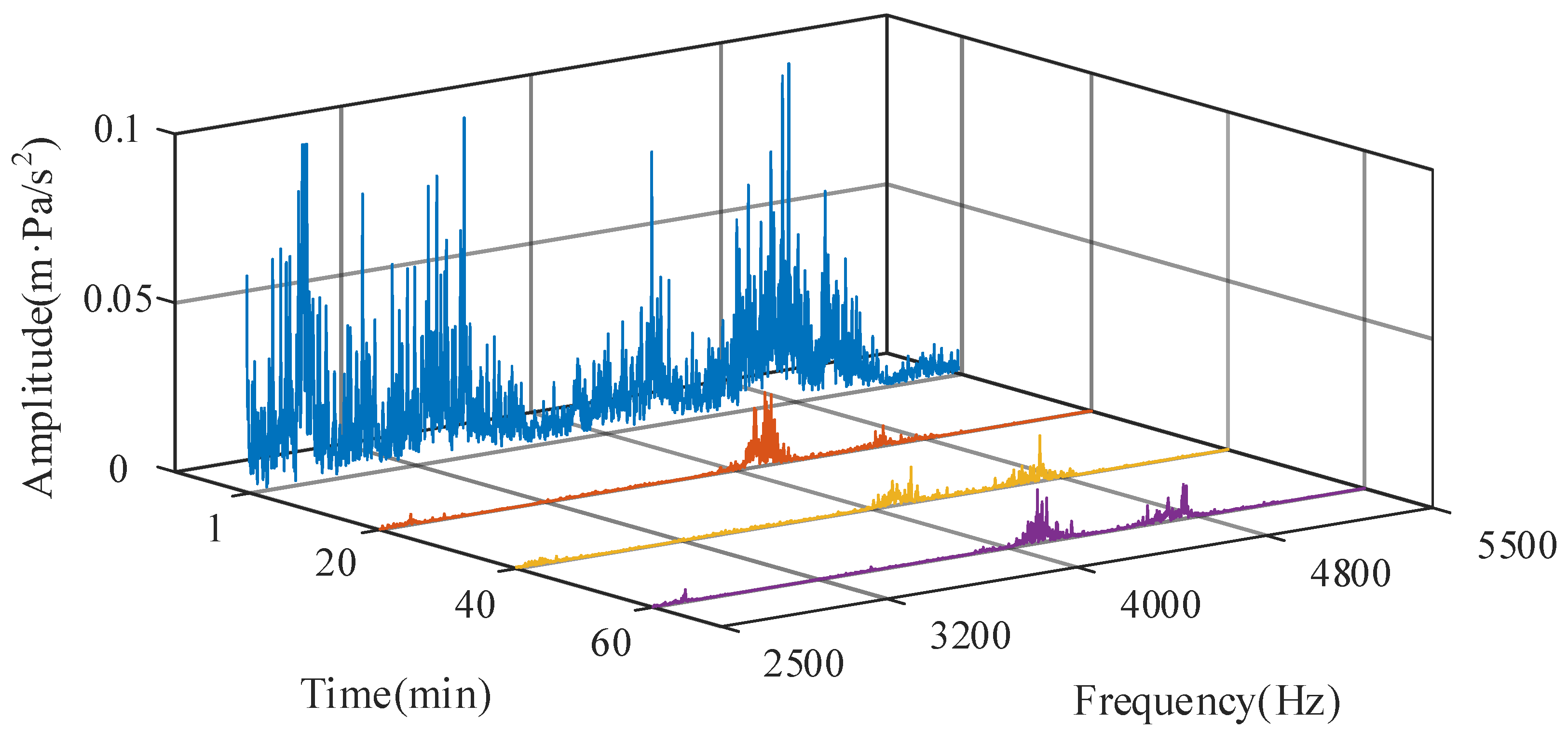
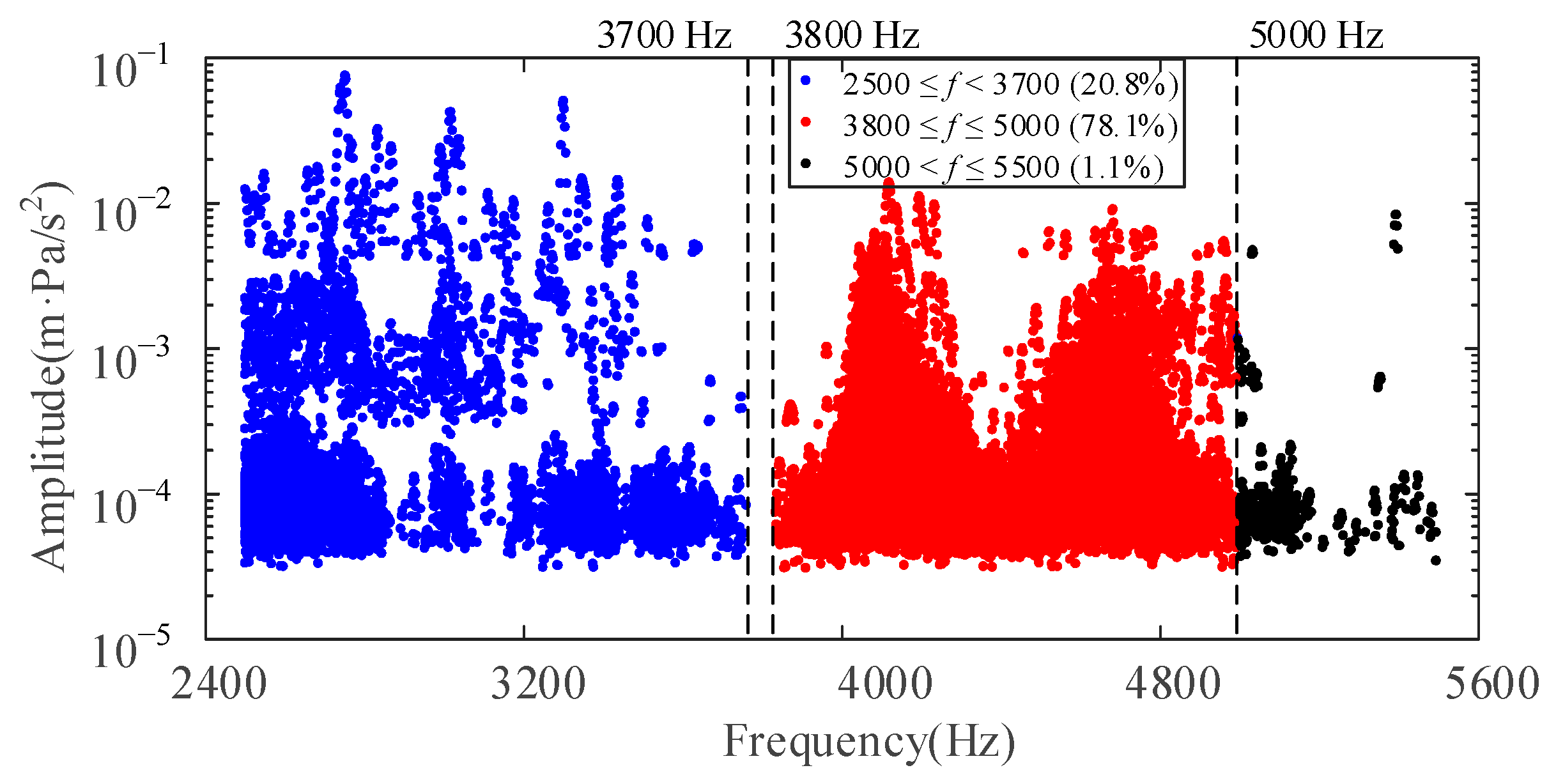
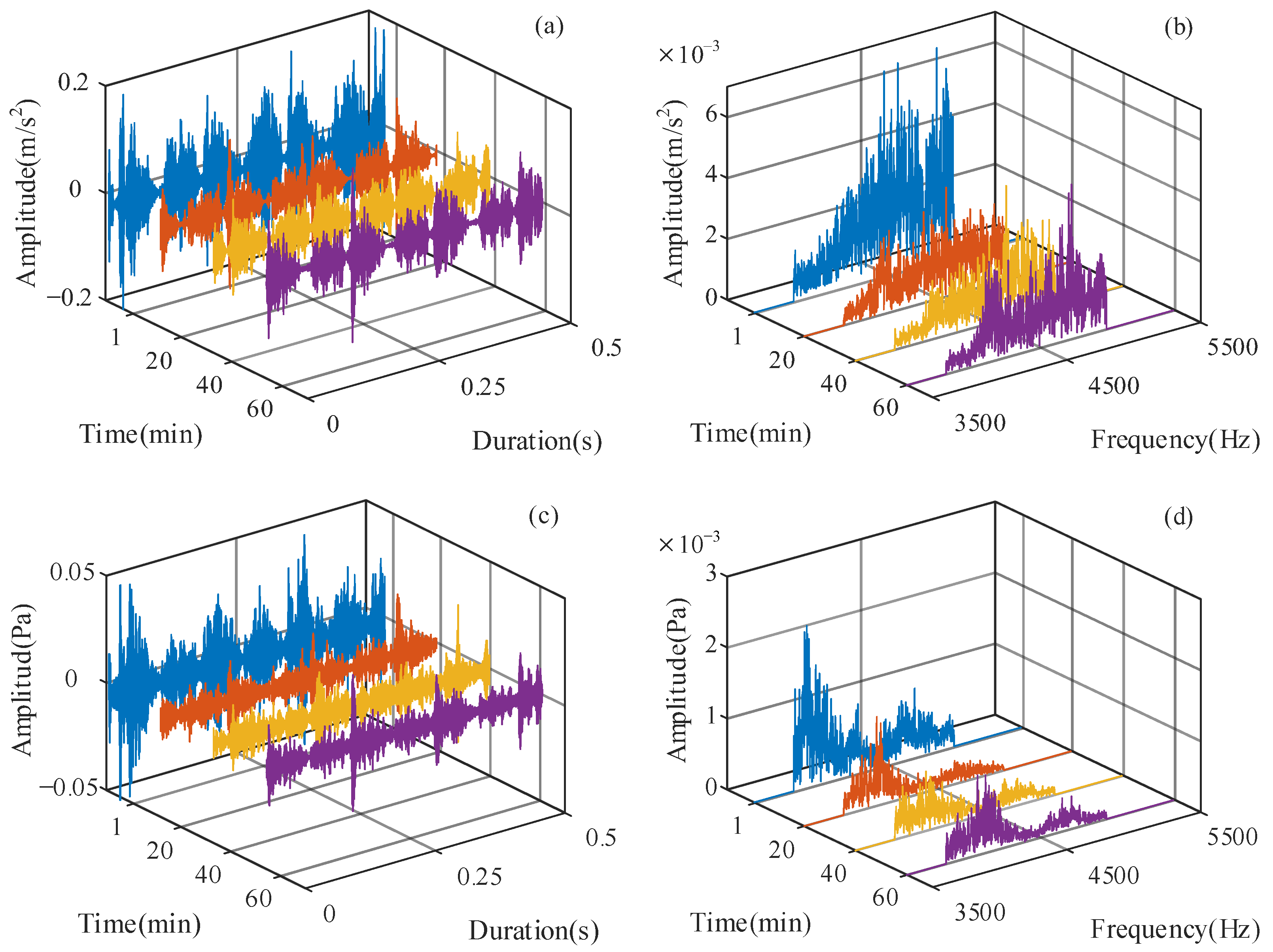
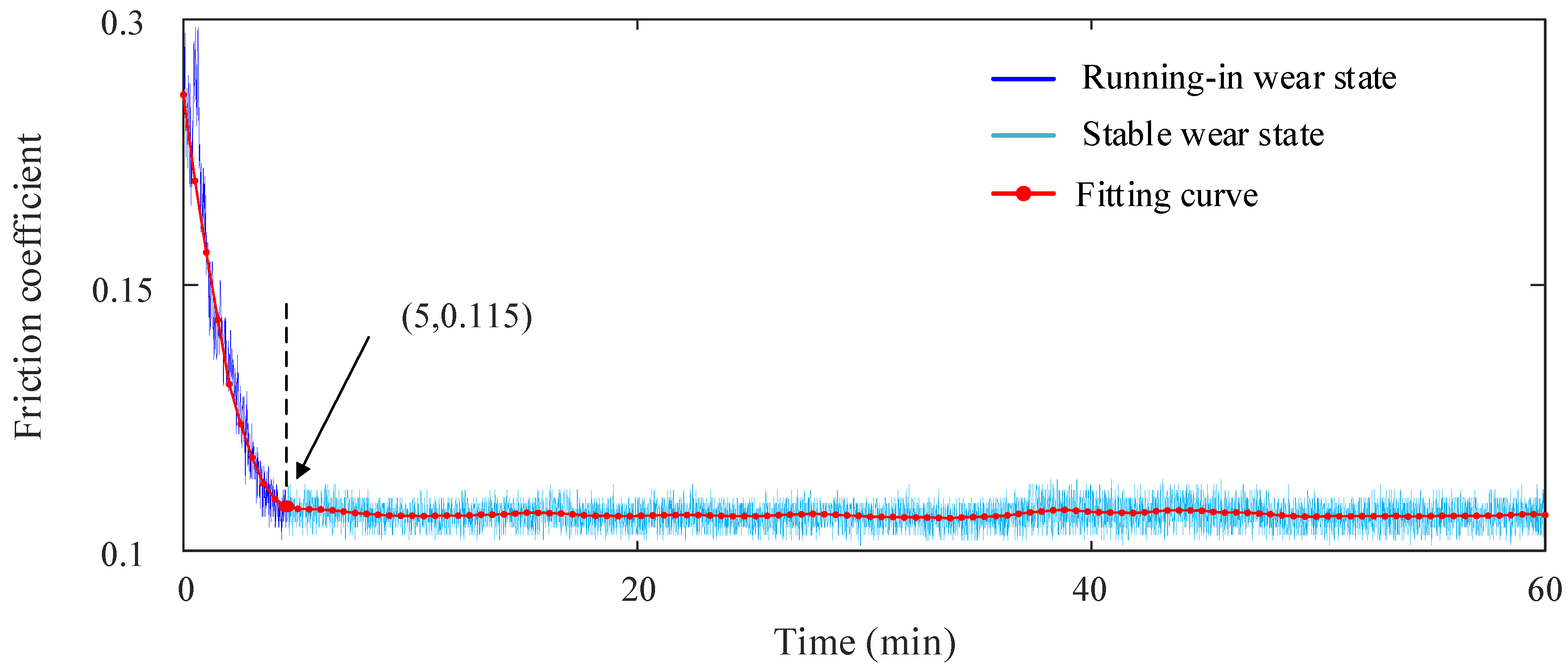
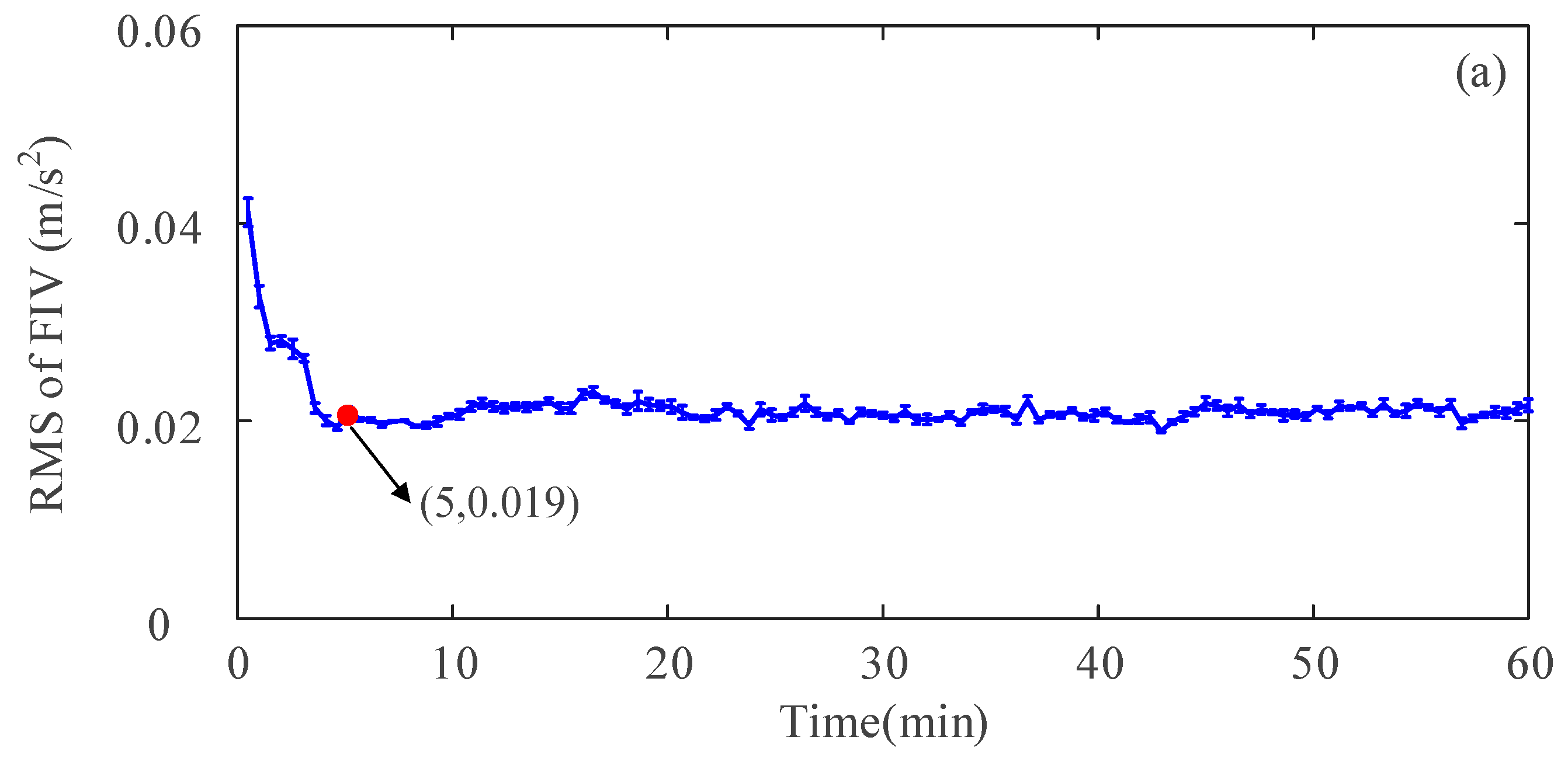
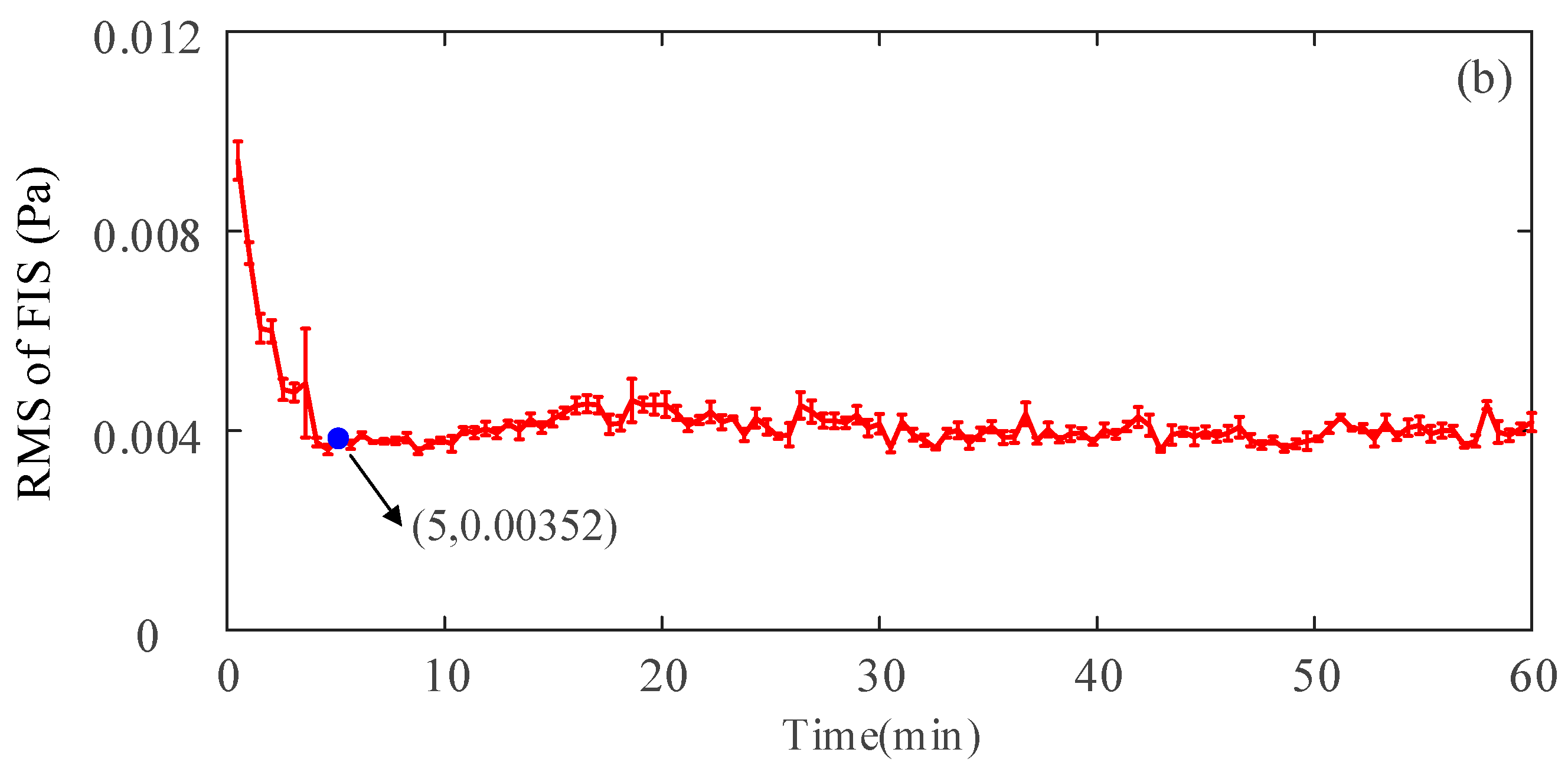
| Friction Pairs | Properties |
|---|---|
| Ball specimen (fixed and upper specimen) | GCr15 steel, Ra 0.13 μm |
| Disk specimen (driven and lower specimen) | C45 steel, Ra 0.73 μm |
| Experiment Settings | Values |
|---|---|
| Normal load | 20 N |
| Lubricant | CD40 lubricating oil |
| Relative humidity | 58% |
| Temperature | 294 K |
| Reciprocating stroke | 5 mm |
| Relative sliding velocity | 0.067 m/s |
| Test duration | 60 min |
| Vibration signals sampling interval | 0.049 ms (10,240 data points) |
Disclaimer/Publisher’s Note: The statements, opinions and data contained in all publications are solely those of the individual author(s) and contributor(s) and not of MDPI and/or the editor(s). MDPI and/or the editor(s) disclaim responsibility for any injury to people or property resulting from any ideas, methods, instructions or products referred to in the content. |
© 2023 by the authors. Licensee MDPI, Basel, Switzerland. This article is an open access article distributed under the terms and conditions of the Creative Commons Attribution (CC BY) license (https://creativecommons.org/licenses/by/4.0/).
Share and Cite
Xing, P.; Zhu, Y.; Li, G.; Liu, T.; Gao, H.; Song, Y.; Zhang, H. A Detecting Method for “Weak” Friction-Induced Vibration Based on Cross-Correlation Analysis between Vibration and Sound Signals. Appl. Sci. 2023, 13, 7468. https://doi.org/10.3390/app13137468
Xing P, Zhu Y, Li G, Liu T, Gao H, Song Y, Zhang H. A Detecting Method for “Weak” Friction-Induced Vibration Based on Cross-Correlation Analysis between Vibration and Sound Signals. Applied Sciences. 2023; 13(13):7468. https://doi.org/10.3390/app13137468
Chicago/Turabian StyleXing, Pengfei, Yanchao Zhu, Guobin Li, Ting Liu, Honglin Gao, Yuchao Song, and Hongpeng Zhang. 2023. "A Detecting Method for “Weak” Friction-Induced Vibration Based on Cross-Correlation Analysis between Vibration and Sound Signals" Applied Sciences 13, no. 13: 7468. https://doi.org/10.3390/app13137468
APA StyleXing, P., Zhu, Y., Li, G., Liu, T., Gao, H., Song, Y., & Zhang, H. (2023). A Detecting Method for “Weak” Friction-Induced Vibration Based on Cross-Correlation Analysis between Vibration and Sound Signals. Applied Sciences, 13(13), 7468. https://doi.org/10.3390/app13137468







